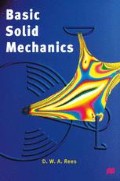Abstract
The engineer’s theory of torsion (e.t.t.) relates the shear stress τ and angular twist θ (rad), that are produced in a solid circular shaft or tube under an externally applied axial torque T. Let the shaft length be L, the material’s rigidity modulus G, the section’s radius r and the polar second moment of area J. Consider the cylindrical core element in Fig. 7.1a of radius r lying within a solid shaft of outer radius R (Fig. 7.lb) when one end is fixed and the other end is free.
Preview
Unable to display preview. Download preview PDF.
Author information
Authors and Affiliations
Copyright information
© 1997 D.W.A. Rees
About this chapter
Cite this chapter
Rees, D.W.A. (1997). Theories of Torsion. In: Basic Solid Mechanics. Palgrave, London. https://doi.org/10.1007/978-1-349-14161-6_7
Download citation
DOI: https://doi.org/10.1007/978-1-349-14161-6_7
Publisher Name: Palgrave, London
Print ISBN: 978-0-333-66609-8
Online ISBN: 978-1-349-14161-6
eBook Packages: EngineeringEngineering (R0)

